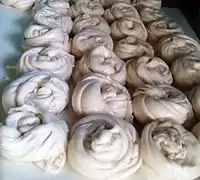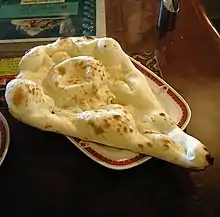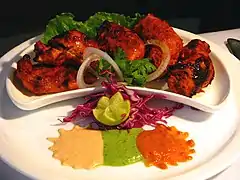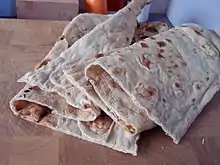 | |
| Alternative names | Porotta, Parotta, Malabar porotta,paratha |
|---|---|
| Type | Flatbread , crispy multi layered bread |
| Place of origin | southern India, Sri Lanka |
| Main ingredients | Maida or Atta, ghee or oil |
Parotta or Porotta is a layered Indian and Sri Lankan flatbread made from Maida or Atta, alternatively known as flaky ribbon pancake. It is very common in the Indian states of Kerala and Tamil Nadu and widely available in other states like Karnataka and Maharashtra and countries like Malaysia, the United Arab Emirates and Sri Lanka.
Porottas are often available as street food[1] and in restaurants. In some places it is also served at weddings, religious festivals and feasts. It is prepared by kneading maida/wheat flour, egg (in some recipes), oil or ghee and water. The dough is beaten into thin layers and later forming a round spiralled into a ball using these thin layers. The ball is rolled flat and pan-fried.[2][3] It is often served with a meat curry, such as chicken, goat, beef, or lamb.
History
Parotta originated in the Tamil-populated Jaffna area of Sri Lanka, and the migrant workers from there introduced it as "Veechu Porotta" or "Ceylon Porotta" in the coastal Tamil Nadu region of India. In Virudhunagar, traditionally, the parotta is deep-fried and is called annai (oil) parotta which is very different from either the veechu parotta or the Malabar parotta. This predates the veechu parotta and has been around for a long time. Parotta became popular all over Kerala during the late 1960s or the early 1980s. During the 1990s, street hawkers (thattukadas) of Kerala further strengthened its status as a local food, and it came to be known as "Kerala Porotta" or "Malabar Parotta" outside of Kerala, owing to the popularity of food from the Malabar region of Kerala which was always globally represented since British times.[4]
Gallery
 Round spiralled dough ball which gives Parotta its flaky layers.
Round spiralled dough ball which gives Parotta its flaky layers.


 Hot Parottas
Hot Parottas_as_served_in_Tamil_Nadu%252C_India.jpg.webp) Kothu Parotta (with Chicken gravy)
Kothu Parotta (with Chicken gravy)
 Roti canai, also known as roti parotta from Southeast Asia.
Roti canai, also known as roti parotta from Southeast Asia.
Health impact
Similar to any food product made from Maida (refined flour), Parotta / Porotta has been deemed unhealthy by some doctors.[5] This has resulted in the introduction and popularization of "atta porotta", which is porotta fully made from atta (whole wheat flour) mostly available northern areas.[6]
See also
References
- ↑ Saravanan, T. (18 January 2013). "Flavours from the footpath". Retrieved 22 December 2019.
- ↑ "Kerala Paratha Recipe". 10 August 2013.
- ↑ Kannampilly, Vijayan (2003). The essential Kerala cookbook. Penguin Books. p. 179. ISBN 0-14-302950-9.
- ↑ Oneal (3 April 2021). "The 4 South Indian dishes that have a foreign origin". Moneycontrol. Retrieved 17 August 2022.
- ↑ Mallady, Shastry V. (12 August 2013). "Parottas loaded with danger, say docs". The Hindu.
- ↑ Indrani, D; Jyothsna Rao, S; Udaya Sankar, K; Rao, G.Venkateswara (2000). "Changes in the physical-chemical and organoleptic characteristics of parotta during storage". Food Research International. 33 (5): 323–329. doi:10.1016/S0963-9969(00)00025-9.



